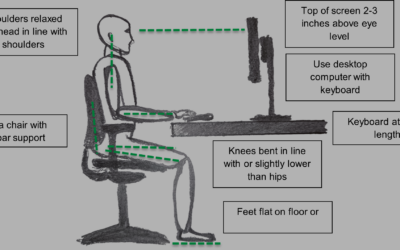What is the difference between an osteopath and a chiropractor? This is one of the most common questions from new patients and it’s never a straightforward one to answer…for me, anyway. I’m an osteopath so it’s difficult to not give an answer that is biased in favour of osteopathy but I try to remain diplomatic in my response. This blog will follow a similar suit as I try to dissect my interpretation of the difference in the two. Hopefully it doesn’t ruffle too many feathers…
The Similarities
Asking the question in the first place suggests there is an awareness that the two professions are similar. This is definitely true so let’s start with the similarities before delving into the differences. The first similarity is the reason why a patient would visit an osteopathic or chiropractic clinic. Osteopaths and chiropractors both treat similar issues with most patients presenting with some kind of back or neck pain (Beliveau et al., 2017; Fawkes et al., 2014) and looking for relief from it. These patients would probably be expecting hands-on treatment too, which is characteristic of both professions with both being known for “clicking” joints. Both professions have other tools in their arsenal such as massage and rehabilitation/exercise prescription.
To learn these methods of treatment osteopaths and chiropractors both have to study at degree level for at least four years to qualify with a Master of Osteopathy (M.Ost) or Masters in Chiropractic (MChiro or MSc Chiro). These qualifications can be used to register with the relevant governing body; the General Osteopathic Council or the General Chiropractic Council. These governing bodies require their registrants to stay up-to-date with Continuous Professional Development (CPD) to ensure the quality and safety of treatment across the country.
Another pertinent similarity between the two professions is that there can be vast differences within them. One chiropractor might treat completely differently to their colleague and the same applies for osteopaths too. Cranial osteopathy is very different to classical osteopathy and, likewise, McTimoney chiropractic is very different to diversified chiropractic. One osteopath might even be more similar to the local chiropractor than the next local osteopath. This makes it difficult to compare the professions as a whole so to compare their differences I will make some generalisations and stereotypical perceptions from the view of a patient but also from myself. Cue disagreement from osteopaths and chiropractors alike…
The Differences
Patients I have treated who have also had chiropractic treatment will commonly report that chiropractic treatments are focused on adjustments in the spine where a joint is “clicked”. This can mean treatment times are shorter than a typical osteopathic treatment, which may be less focussed on one technique and be more likely to include other soft-tissue techniques like massage on top of the “clicking”. Chiropractors will often make more frequent use of tools such as an “activator” or a “nervoscope” and will often include xrays in their examination of a patient to assess the posture of the spine. Osteopaths tend to only use palpation, orthopaedic tests and assess movement patterns rather than using xrays.
The philosophies behind each profession have historically been different but easier to distinguish. Osteopaths have historically theorised that when blood and lymph flows freely, associated tissues in the body can function healthily and disease is avoided. By maintaining the function of the structures of the body, health can be maintained. For example, keeping the rib cage mobile will help breathing and therefore help the body’s ability to take in oxygen et cetera. Chiropractors have historically theorised that it is the nerve supply to an area that is crucial to its healthy function and that if this is impeded then disease will arise. Chiropractic philosophy also supports the structure-function notion.
These concepts, for both professions, were conceived in the 19th century and are a little dated now. As allopathic medicine has evolved with research over the past 100 years, so have osteopathy and chiropractic. In my opinion, osteopaths and chiropractors need to continually adapt according to the latest research and evidence. If all osteopaths and chiropractors are practising according to the latest evidence, then naturally the two professions will probably become more and more similar than different to each other. Physiotherapists fall into this category too. Physiotherapists have traditionally focused more on exercise prescription, which has good evidence for helping a lot of musculoskeletal conditions. This is something that osteopaths and chiropractors are adopting more readily than yesteryear; giving their patients exercises to help themselves away from the clinic to maximise the benefit of the treatment in the clinic.
In Summary
To summarise and answer the original question, I would say that the difference a patient would probably find between an osteopath and a chiropractor is that a chiropractor will probably focus on “clicking”, an osteopath will probably use a few more soft-tissue techniques, a chiropractor might use xrays and an osteopathic appointment will probably last longer. In reality the main difference is simply the human being they are seeing. As long as that practitioner treats according to up-to-date evidence, gives you advice to help yourself and has no ulterior money-oriented motive then their title shouldn’t matter too much.
(I’m still biased at heart though so Book Online and come and see an osteopath to see how we can help you!)
Reference list
Beliveau, P.J.H., Wong, J.J., Sutton, D.A., Simon, N.B., Bussières, A.E., Mior, S.A. and French, S.D. (2017). The chiropractic profession: a scoping review of utilization rates, reasons for seeking care, patient profiles, and care provided. Chiropractic & Manual Therapies, 25(1).
Fawkes, C.A., Leach, C.M.J., Mathias, S. and Moore, A.P. (2014). A profile of osteopathic care in private practices in the United Kingdom: A national pilot using standardised data collection. Manual Therapy, 19(2), pp.125–130.



